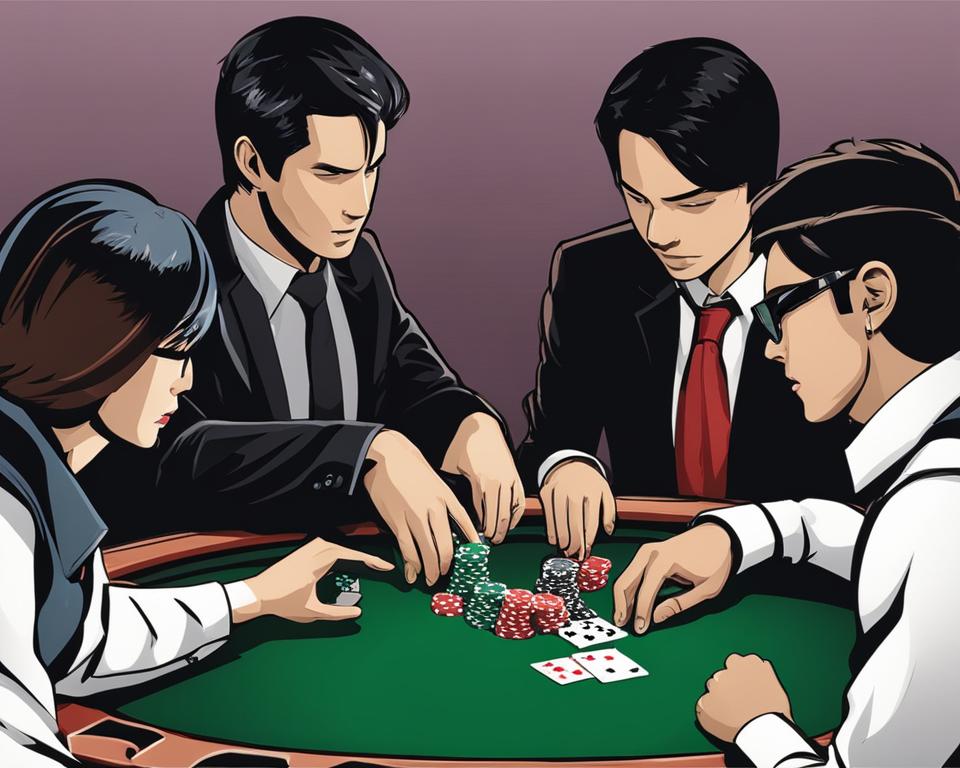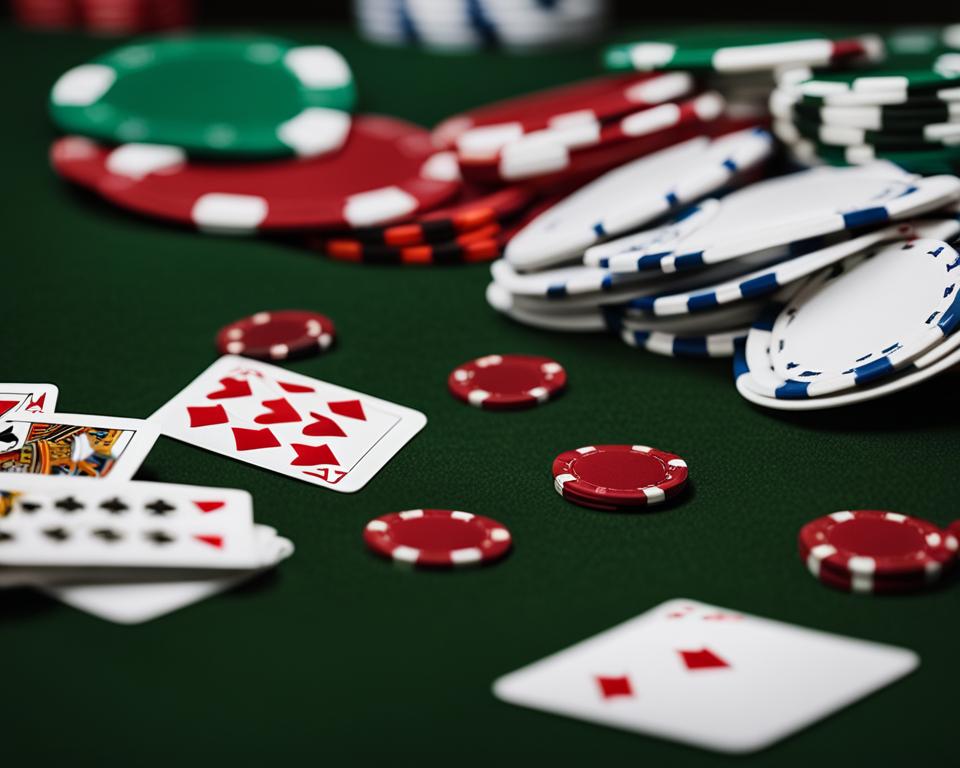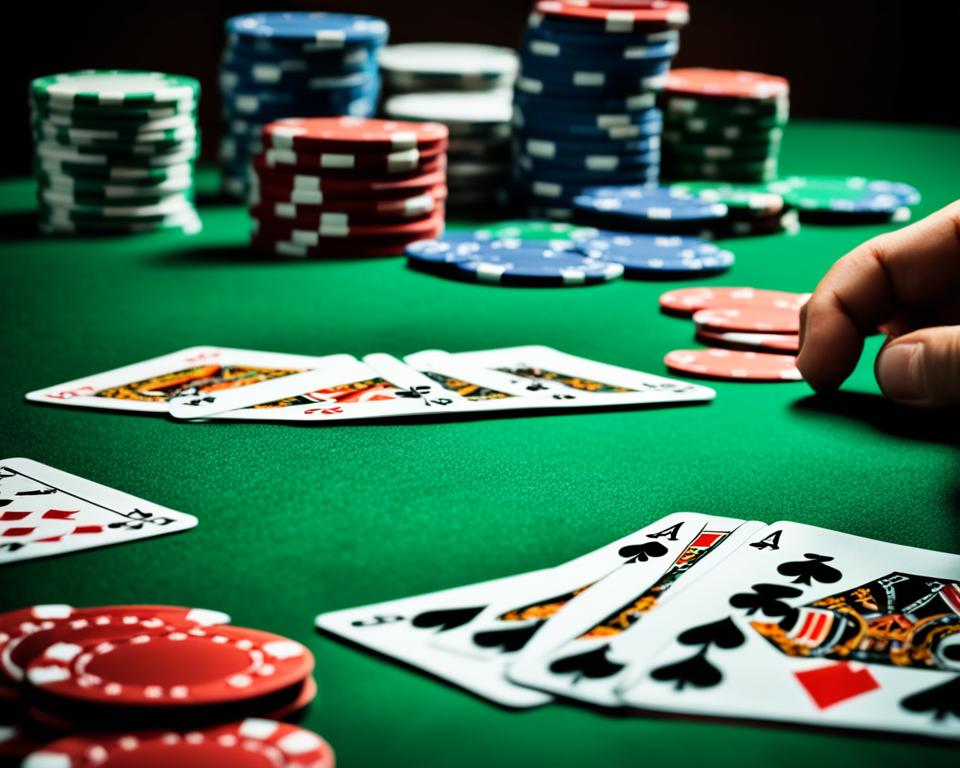Communication is crucial at the poker table, and one way players convey information without speaking is through poker hand signals. These signals help prevent misunderstandings and maintain the flow of the game. For newbies, understanding and using these hand signals is essential to feel confident and play like a pro. In this beginner’s guide to poker hand signals, we’ll explore the essential tips to help you navigate the world of poker gestures.
Key Takeaways:
- Mastering poker hand signals is crucial for clear and efficient communication at the poker table.
- Common poker hand signals include folding by pushing cards forward, checking by tapping the table, calling by placing chips in front of you, and raising by adding more chips.
- Using hand signals effectively requires understanding their meanings, using clear gestures, and paying attention to other players’ signals.
- Poker hand signals offer advantages such as faster gameplay, minimized miscommunication, and increased confidence for beginners.
- Professional poker players often use advanced hand signals to convey complex actions or strategies.
Importance of Poker Hand Signals
Poker hand signals play a crucial role in facilitating clear and efficient communication among players at the poker table. By utilizing hand gestures, players can convey their intentions and actions quickly and easily, without disrupting the flow of the game. These essential poker hand signals help prevent confusion and ensure a smooth gameplay experience for everyone involved.
Mastering poker hand signals allows players to communicate effectively while focusing on their strategic decisions. Verbal communication is not always feasible or desirable during a game, especially in high-stakes situations where every move matters. Poker hand gestures serve as a non-verbal language that transcends the need for spoken words, enabling players to convey their thoughts seamlessly.
With the mastery of essential poker hand signals, players can communicate important actions such as folds, checks, calls, raises, and more, without uttering a word. This level of non-verbal understanding is especially important in live poker games where noise and distractions can impede verbal communication. By relying on hand signals, players can maintain a quiet and focused atmosphere at the table.
Furthermore, poker hand signals promote fairness and prevent misunderstandings among players. Clear and universally recognized gestures ensure that everyone at the table can understand the intended action, eliminating any potential disputes or confusion. This streamlined communication enhances the integrity of the game, enabling players to concentrate on their strategies and decisions.
In addition to their practical benefits, mastering poker hand signals can also contribute to the overall enjoyment of the game. When players seamlessly convey their intentions through hand gestures, the gameplay becomes more fluid and engaging. This non-verbal interaction adds another layer of excitement and camaraderie among players, creating a memorable poker experience for everyone involved.
Achieve Precision and Clarity with Poker Hand Signals
By mastering poker hand signals, players can elevate their gameplay to new heights. These signals provide a means of communication that goes beyond words, allowing players to convey their intentions accurately and efficiently. Whether you’re a newbie or an experienced player, understanding and utilizing essential poker hand signals is a valuable skill that can enhance your overall performance at the table.
Common Poker Hand Signals
When playing poker, it’s crucial to understand and use the common hand signals that players use to communicate their actions and intentions. These signals are widely recognized and used in poker rooms and tournaments around the world. By familiarizing yourself with these popular poker hand signals, you’ll be able to navigate the game smoothly and effectively.
Here are some of the most commonly used poker hand signals:
- To signal a fold, push your cards forward on the table. This signifies that you are not participating in the current round and are giving up your hand.
- When you want to indicate a check, you can do so by tapping the table gently with your hand. This signifies that you wish to continue in the game without placing any further bets.
- For a call, place the required chips in front of you in a neat stack. This indicates that you are matching the current bet and wish to continue playing.
- If you want to signal a raise, start by placing the required chips in front of you. Then, add more chips on top to indicate the amount you wish to raise. Raising implies that you want to increase the current bet and challenge the other players.
By using these common hand signals, you can effectively communicate your actions and ensure a smooth gameplay experience. These signals are easily understood by fellow players, preventing any misunderstandings or disruptions during the game.
Mastering Poker Hand Signals
“Understanding and mastering poker hand signals is essential for a seamless poker experience. These signals not only enhance communication but also demonstrate your knowledge of the game.”
Remember, it’s important to use clear and deliberate gestures when employing hand signals. Be attentive to other players’ signals and respond accordingly. In case you’re unsure about a particular signal or its meaning, don’t hesitate to ask for clarification. By practicing and incorporating these signals into your gameplay, you’ll become proficient in using them and elevate your poker skills.

Using Poker Hand Signals Effectively
To make the most of poker hand signals, it’s crucial to understand their meanings and when to use them. By using clear and deliberate gestures, you can communicate your actions and intentions accurately, preventing any confusion at the poker table.
When playing poker, pay close attention to the hand signals used by other players. These signals can provide valuable information about their strategies and intentions. By observing and interpreting their signals, you can make more informed decisions and respond accordingly.
If you encounter a hand signal that you’re unfamiliar with or unsure about its meaning, don’t hesitate to ask for clarification. It’s always better to seek understanding rather than make assumptions that could lead to misunderstandings during the game.
To ensure effective communication, practice using poker hand signals regularly. By doing so, you’ll become more comfortable and proficient in their use. Remember, a consistent and accurate interpretation of hand signals helps maintain the integrity of the game, creating a fair and enjoyable playing experience for everyone involved.
Mastering the art of using poker hand signals effectively enhances your overall playing experience. It allows for smoother gameplay, efficient communication, and a deeper understanding of your opponents’ moves. By incorporating these gestures into your poker strategy, you’ll be able to elevate your game and make your mark at the poker table.
Advantages of Poker Hand Signals
Poker hand signals offer several advantages for both new and experienced players. They provide a convenient and efficient way to communicate without relying on verbal exchanges, allowing for faster gameplay and reducing the time spent on unnecessary conversation. By using hand signals, players can convey their actions and intentions quickly, ensuring a smooth and uninterrupted flow of the game.
One of the key advantages of poker hand signals is the minimization of miscommunication or misunderstandings. Verbal communication can sometimes lead to confusion or misinterpretation, especially in noisy or crowded environments. By relying on hand signals, players eliminate the risk of misheard or misinterpreted instructions, promoting a fair and enjoyable gaming experience for all participants.
For newbies, mastering essential poker hand signals can be particularly beneficial. By familiarizing themselves with these signals, beginners can feel more confident and knowledgeable in their interactions at the poker table. It helps them align with the standard practices of the game, boosting their overall understanding and engagement.
“Poker hand signals enhance communication, reduce misunderstandings, and boost confidence for newbies.”
Overall, incorporating poker hand signals into gameplay offers numerous advantages. It streamlines the gaming process, facilitates efficient communication, and enhances the overall experience for players of all skill levels.
| Advantages of Poker Hand Signals |
|---|
| Faster gameplay |
| Minimization of miscommunication |
| Enhanced confidence for newbies |
Professional Poker Hand Signals
In professional poker games, players often utilize a range of advanced hand signals to convey more intricate actions and strategies. These professional poker hand signals go beyond the basics and exhibit a higher level of skill and understanding of the game.
Mastering professional poker hand signals requires both experience and practice. By familiarizing themselves with these advanced signals, players can gain a competitive edge and enhance their overall performance at the table.
Advanced Hand Signals
Professional poker hand signals encompass a variety of actions and strategies that can be conveyed non-verbally. Some examples include:
- Signaling a specific bet size: Advanced players can use hand signals to indicate the precise amount they wish to bet, ensuring clarity and precision in their actions.
- Indicating specific card actions: Hand signals can be employed to communicate specific card actions, such as a check-raise or a specific play strategy.
- Conveying non-verbal information: In team poker games, players may utilize hand signals to transmit non-verbal information to their teammates, allowing for covert communication and strategic collaboration.
These professional hand signals require finesse and subtlety in their execution. Players must develop a deep understanding of the game and its nuances to effectively utilize these signals and stay one step ahead of their opponents.
Below is an example of a professional poker hand signal in action:
“As the player evaluates his hand, he subtly taps his index finger twice on the table, indicating to his teammate that he plans to make a small bet to test the waters. This non-verbal communication helps the players coordinate their actions strategically without raising suspicion.”

Poker Hand Signals Etiquette
When playing poker and using hand signals, it’s essential to adhere to proper etiquette. By following these guidelines, you can ensure a respectful and enjoyable atmosphere at the poker table.
Avoid making exaggerated or excessive gestures that may distract or annoy other players. Keep your signals concise and deliberate, using them as a clear means of communication without causing disruptions.
Maintain a calm and composed demeanor while using hand signals. This demonstrates respect for the game and your fellow players, creating a positive playing environment.
Be aware of your surroundings and avoid blocking the view of other players when using hand signals. This allows everyone at the table to easily observe and understand the actions being conveyed.
Remember, poker hand signals are meant to streamline the gameplay experience and promote efficient communication. By practicing good etiquette, you contribute to a harmonious and enjoyable poker environment for all players involved.
Quick Tips for Learning Poker Hand Signals
Learning poker hand signals is essential for newbies who want to navigate the poker table with confidence. By understanding and effectively using hand signals, you can communicate your actions and intentions seamlessly without uttering a single word. Here are some quick tips to help you master the art of poker hand signals:
- Observe and Familiarize: Start by observing other players’ hand signals during games. Pay attention to the common signals used, such as folding, checking, calling, and raising. Take note of the gestures and their meanings to build your understanding.
- Practice Makes Perfect: The best way to become proficient in using hand signals is to practice them yourself. Play casual games with friends or participate in online poker rooms where you can apply the signals in real-time scenarios. The more you practice, the more natural and effortless your hand signals will become.
- Tap Into Tutorial Resources: Watch tutorial videos or read articles that demonstrate the proper use of poker hand signals. These resources provide visual examples and explanations that can help you grasp the nuances of each signal. Utilizing these educational tools will accelerate your learning process.
- Memorize the Signals: Take the time to memorize the different hand signals and their meanings. By committing them to memory, you’ll be able to use them instinctively during gameplay without hesitation or uncertainty. Memorization is key to becoming fluent in the language of poker hand signals.
With these quick tips, you’ll be well on your way to mastering poker hand signals. Remember, practice and familiarity are essential in becoming proficient. Embrace the opportunity to incorporate hand signals into your poker strategy, and watch as your gameplay reaches new heights.
Enhancing Your Poker Experience with Hand Signals
Using hand signals in poker not only improves communication but also enhances your overall poker experience. By understanding and using the appropriate signals, you can enjoy a smoother and more efficient gameplay.
Hand signals help to create a sense of camaraderie and mutual understanding among players, fostering a positive and enjoyable atmosphere at the poker table. Incorporate hand signals into your poker strategy to elevate your game to the next level.
Benefits of Using Hand Signals:
- Efficient Communication: Hand signals allow you to convey your actions and intentions quickly, without the need for verbal communication. This speeds up the game and reduces the chances of misunderstandings.
- Smooth Gameplay: By using hand signals, you can maintain the flow of the game without interruptions. This helps to keep the game moving and ensures a more enjoyable experience for everyone at the table.
- Clear and Fair Actions: Mastering poker hand signals enables you to make concise and deliberate gestures, leaving no room for interpretation. This ensures that your actions are understood by all players, promoting fairness and preventing disputes.
- Enhanced Strategy: Incorporating hand signals into your poker strategy allows you to focus more on your gameplay and less on verbal communication. This enables you to make quick and calculated decisions without giving away valuable information to your opponents.
Implementing Effective Hand Signals:
To effectively use hand signals in poker, it’s important to remember a few key tips:
- Learn the Common Signals: Familiarize yourself with the standard hand signals used in poker, such as folding, checking, calling, and raising. Understanding these signals will allow you to communicate easily with other players.
- Be Clear and Deliberate: When using hand signals, make sure your gestures are clear and deliberate. Avoid any ambiguous or confusing movements that may lead to misinterpretation.
- Pay Attention to Others: Observe the hand signals used by other players at the table. This will help you understand their actions and make more informed decisions based on their signals.
- Practice and Refine: Take the time to practice using hand signals in both casual games and online poker rooms. This will help you become more confident and fluent in using the signals during live gameplay.
By incorporating hand signals into your poker routine, you can enhance your overall poker experience and elevate your gameplay to new heights.
Conclusion
Poker hand signals are an essential aspect of the game, providing newbies with a clear and efficient way to communicate their actions and intentions without speaking. By understanding and mastering these signals, players can enhance their overall playing experience and feel more confident at the table.
Incorporating hand signals into your poker strategy allows for effective communication and maintains the smooth flow of gameplay. Whether you’re indicating a fold, check, call, or raise, using hand signals helps prevent confusion and ensures a fair and enjoyable gaming experience for all players.
By familiarizing yourself with common hand signals and practicing their use, you can become proficient in their application. Paying attention to other players’ signals and practicing good poker hand signals etiquette demonstrates respect for the game and creates a positive atmosphere at the table.
Overall, mastering essential poker hand signals is a valuable skill for newbies and experienced players alike. It not only improves communication but also adds a level of professionalism to your gameplay. So, next time you’re at the poker table, remember to incorporate these hand signals into your strategy and elevate your poker experience to new heights.
FAQ
What are poker hand signals?
Poker hand signals are non-verbal gestures used by players at the poker table to communicate their actions and intentions without speaking. They help to prevent misunderstandings and maintain the flow of the game.
Why are poker hand signals important?
Poker hand signals are important because they enable clear and efficient communication among players. They reduce the need for verbal communication, minimize the risk of miscommunication, and ensure a fair and enjoyable gaming experience.
What are some common poker hand signals?
Common poker hand signals include signaling a fold by pushing your cards forward, indicating a check by tapping the table, showing a call by placing the required chips in front of you, and signaling a raise by placing the required chips in front of you and then adding more.
How can I use poker hand signals effectively?
To use poker hand signals effectively, it’s important to understand their meanings and when to use them. Use deliberate and clear gestures, pay attention to other players’ signals, and ask for clarification if unsure. Additionally, practice good etiquette by avoiding distracting or exaggerated gestures.
What are the advantages of using poker hand signals?
Using poker hand signals allows for faster gameplay, reduces the time spent on verbal communication, and minimizes the risk of miscommunication. They also help beginners feel more confident and knowledgeable, as they become familiar with the standard practices of the game.
Are there professional poker hand signals?
Yes, in professional poker games, players often use advanced hand signals to convey more complex actions or strategies. These signals can include signaling a specific bet size, indicating a specific card action, or conveying non-verbal information to teammates in team poker games.
What is the etiquette for using poker hand signals?
When using poker hand signals, it’s important to practice good etiquette. Avoid making distracting or exaggerated gestures, use the signals in a deliberate and respectful manner, and be aware of your surroundings to avoid blocking the view of other players.
How can I quickly learn poker hand signals?
To quickly learn poker hand signals, observe other players, practice using the signals yourself in casual games or online poker rooms, watch tutorial videos or read articles on proper hand signal use, and take the time to memorize the different signals and their meanings.
How do poker hand signals enhance the overall poker experience?
By understanding and using poker hand signals, players can enjoy smoother and more efficient gameplay. They create a sense of camaraderie and mutual understanding among players, fostering a positive and enjoyable atmosphere at the poker table.





